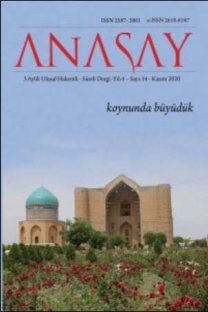İSTANBUL KARACAAHMET MEZARLIĞI’NDA YER ALAN SANATKÂR MEZAR TAŞLARI HAKKINDA BİR DEĞERLENDİRME
Mezar taşları, Türk sanatı içerisinde önemli bir yere sahiptir. Orta Asya’dan itibaren devam eden mezar taşı mimarisi gelişimini Anadolu’da sürdürmüş ve bu gelişimin sonucu olarak sanatsal örnekler ortaya çıkmıştır. Mezar taşları ait olduğu dönemin ve bölgenin karakteristik özelliklerine göre şekil aldığı bilinmektedir. Gerek Anadolu örneklerinde gerekse de İstanbul’un tarihi mezarlıklarında bu geleneğin birçok örneği bulunmaktadır. Bu örneklerden birisi de İstanbul Karacaahmet Mezarlığı’dır. Söz konusu mezarlıktaki mezar taşı örnekleri, Anadolu örneklerinin zaman içerisinde gelişen süsleme ve teknik detayların farklı bir örneği olarak ortaya çıkmış ve özgün örnekler olarak değerlendirilmiştir. Mezar taşlarındaki bu tipolojik gelişimin en belirgin örnekleri İstanbul’da Eyüp Sultan Haziresi, Merkez Efendi Mezarlığı, Edirne Kapı Mezarlığı, Beşiktaş Yahya Efendi Haziresi ve Karacaahmet Mezarlığı’dır. Çalışmaya konu olan İstanbul Karacaahmet Mezarlığı’da bahsi geçen bu hazirelerin en önemli örneklerindendir. Bu çalışma mezarlıkta yer alan sanatkâr mezar taşlarını teknik ve süsleme kompozisyonları, süsleme özellikleri, sanatkârların hangi tarikata bağlı olduğu gibi özellikleri ortaya koymayı hedeflemektedir. Bu bağlamda incelenen sanatkâr mezar taşlarında bulunan süsleme detayları, taş işçiliği, ketebe imzalı örnek, manzum-mensur ayrımı, başlık tipleri ve formları hakkında bilgilere yer verilmiştir. Sanatkârların başlık formları hakkında bilgilere yer verilirken saha araştırması sonucunda elde edilen veriler çalışmaya ışık tutmuştur. Çalışmada aynı zamanda bilimsel araştırma tekniklerinden olan kaynak tarama ve literatür analiz yöntemlerinden faydalanılmıştır.
AN EVALUATION ABOUT THE ARTIST'S TOMBSTONES AT THE KARACAHMET CEMETERY, ISTANBUL
Gravestones have an important place in Turkish art. The tombstone architecture, which has been continuing since Central Asia, continued its development in Anatolia and artistic examples emerged as a result of this development. It is known that the tombstones take shape according to the characteristics of the period and region to which they belong. There are many examples of this tradition both in Anatolian examples and in the historical cemeteries of Istanbul. One of these examples is the Istanbul Karacaahmet Cemetery. The tombstone samples in the cemetery in question emerged as a different example of the ornamentation and technical details of the Anatolian samples that developed over time and were evaluated as original samples. The most prominent examples of this typological development in tombstones are Eyüp Sultan Cemetery, Merkez Efendi Cemetery, Edirne Gate Cemetery, Beşiktaş Yahya Efendi Cemetery and Karacaahmet Cemetery in Istanbul. The Istanbul Karacaahmet Cemetery, which is the subject of the study, is one of the most important examples of these burials. This study aims to reveal the technical and ornamental compositions of the artisan tombstones in the cemetery, their ornamentation features, and the characteristics of the artisans to which sect they belong to. In this context, information is given about the decoration details, stonework, the sample with the signature of the ketebe, the distinction between verse and prose, the types and forms of the headdresses found in the tombstones of the craftsmen examined. While giving information about the title forms of the craftsmen, the data obtained as a result of the field research shed the main light on the study. At the same time, resource scanning and literature analysis methods, which are scientific research techniques, contributed to the study.
___
- Akar A. (1974) "Eski Türk Mezar Taşı Süslerine Dair”, Sanat Dünyamız, 2. Sayı, İstanbul.
- Arseven, C. E. (1975), ‘’Sarık’’ Sanat Ansiklopedisi, C. IV, İstanbul, Milli Eğitim Bakanlığı Yayınları.
- Berk, S. (2006), “Zamanı Aşan Taşlar”, Zeytinburnu Belediyesi Yayınları, İstanbul.
- Ceyhan, S. (2010), Osmanlı Tâcnâme Literatürüne Göre Derviş Tacı ve Abdullah Salâhaddîn-i Uşşâkī’nin Cevâhir-i Tâc-ı Hilâfet Risâlesi İslam Araştırmaları Dergisi, sayı: 25.
